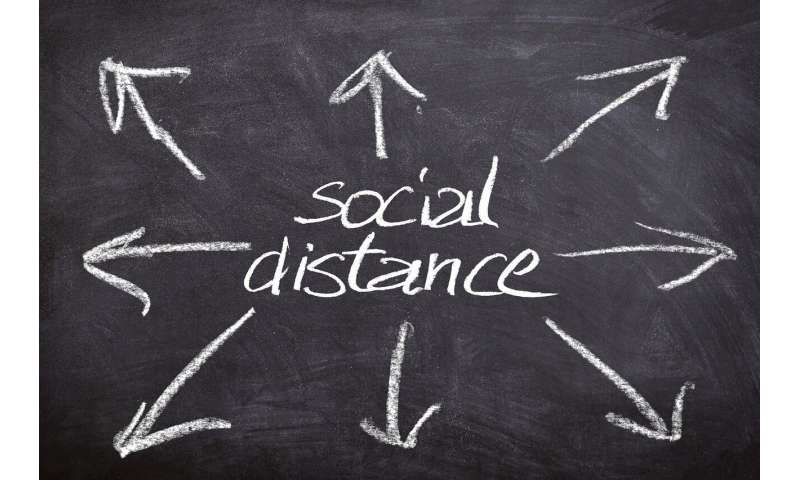
Lifting the lockdown in favor of strategic distancing, could lead to improved compliance with official recommendations and 'keep the curve' flat, in terms of COVID-19 infections, according to a report today from Oxford researchers.
In a study in the journal Nature Human Behaviour, Dr. Per Block, Professor Melinda Mills and a team from Oxford's Leverhulme Centre for Demographic Science, in collaboration with researchers from Zurich, have carried out extensive modeling on the impact of loosening the lockdown on the course of the virus. They demonstrate that the infection rate can be kept considerably lower by strategically reducing contact, compared to simple social distancing in a post-lockdown world.
According to the research study, "Compliance with recommendations strategically to reduce contact is more favorable than compliance with complete isolation and, thus, can keep the curve flat in the long run."
Dr. Block, lead author of the article states, "We demonstrate that strategic reduction of contact can strongly increase the efficiency of social distancing measures, introducing the possibility of allowing some social contact while keeping risks low.
"This approach provides nuanced insights to policy makers for effective social distancing which can mitigate negative consequences of social isolation."
He adds: "We demonstrate how simple changes within individuals' social networks, and network-informed constellations within businesses and schools, can alter the rate and spread of the virus."
The Oxford study looks at three strategic options:
- Increasing similarity of contacts (homophily), by temporarily restricting contact to those who share key similar features, such as living in the same neighborhood, where possible.
- Reducing interaction with people who are not connected to one's usual social contacts, in order to decrease ties that bridge social clusters.
- Repeatedly interacting with the same social contacts (repetition), by creating micro-communities, commonly referred to as social bubbles.
Each strategy offers the prospect of increased social contact, in a clearly defined way. The study maintains, "All three of our strategies substantially slow the spread of the virus compared to either no intervention or simple, un-strategic social distancing."
The third strategy, of limiting interaction to a few repeated contacts, was the most effective strategy. Maintaining similarity across contacts, such as only interacting with people who live within the same neighborhood, and decreasing ties that bridge social clusters, such as occasional acquaintances, were also found to be highly effective, when compared to reducing contact at random.
Based on the findings, the authors suggest that reducing high-impact contact, rather than reducing or removing it overall, can mitigate adverse social, behavioral and economic impacts of lockdown approaches while keeping risks low. By offering different social distancing strategies, the article also proposes alternatives to social bubbles in cases when forming these is not practicable.
The authors suggest that all discussed approaches mitigate the recognized psychological and physical harms of prolonged social distancing. Recommendations to reduce contact strategically may be more palatable to people than complete isolation—and therefore lead to higher adherence. Translating the simulation results to understand how alteration of social networks can reduce infections, the authors show how enacting the three strategies 'flattened the curve' across a wide variation in simulated scenarios.
The study further maintains, "Strategic contact reduction has a substantive effect on flattening the curve compared to simple social distancing consistently across all scenarios...Since most individuals in a post-lockdown world need to interact across multiple social circles (e.g., workplace, extended family), employing only one strategy might not be practical."
However, the estimations from this study suggest even a mix of strategies is preferable, compared to adopting no strategies of reducing contact.
The research states, "We provide clear social network-based strategies to empower individuals and organizations to adopt safer contact patterns across multiple domains by enabling individuals to differentiate between 'high-impact' and 'low-impact' contacts.
"Instead of blanket self-isolation policies, the emphasis on similar, community-based, and repetitive contacts is both easy to understand and implement thus making distancing measures more palatable over longer periods of time."
Explore further
Citation: Study proposes new strategies for social distancing (2020, June 4) retrieved 4 June 2020 from https://ift.tt/3cE0PrP
This document is subject to copyright. Apart from any fair dealing for the purpose of private study or research, no part may be reproduced without the written permission. The content is provided for information purposes only.
"strategy" - Google News
June 04, 2020 at 06:07PM
https://ift.tt/3cE0PrP
Study proposes new strategies for social distancing - Phys.org
"strategy" - Google News
https://ift.tt/2Ys7QbK
https://ift.tt/2zRd1Yo
Bagikan Berita Ini















0 Response to "Study proposes new strategies for social distancing - Phys.org"
Post a Comment